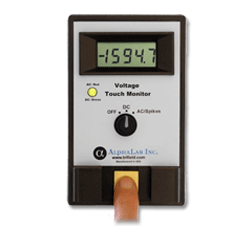Description
The monitor reads the voltage on a finger (which is identical to the voltage at every other point on the body). It can detect as little as 1/10 volt in two modes: DC and AC/Spikes (ESD transients). In the DC mode, the displayed voltage is either positive or negative, and is usually very low if grounding is being worn and is functioning properly. Higher DC voltages (even while grounded) occur if a DC ionizer is blowing too close or if the person rubs against a high-static material or comes in contact with metal at a DC potential. If personal grounding is not being used, any DC signal can build up over time, and the DC mode continues to show the instantaneous body voltage as it changes. In the AC/Spikes mode, any transient voltage spike at least 1/2 millisecond long is temporarily displayed. If there are several consecutive spikes, only the highest is displayed, regardless of polarity. If the signal is a repetitive (AC) wave, the peak voltage is displayed, but always as a positive number. Even when proper grounding is worn, several tens of volts often occur with transients and AC. Maximum error for DC and AC is only 2% of the reading +/- 0.1 volt.
With the touch of a finger, this monitor can be reliably used to warn and educate those who work in the most static-sensitive environments, including areas in which a fraction of a volt is critical. When used to verify the operation of wrist straps and conductive footwear, it detects problems in the entire system. This includes unexpected bad ground plugs, bad floor conductance, voltage transients or AC that may be present from the air near ionizers or from contact with equipment that has a ground fault. (None of these problems can be detected with wrist strap or footwear testers). With a range of +/-1999.9 volts, it can even quantify high-voltage problems.
Encourage personnel to use it periodically; the monitor can be left on for years. (Power consumption is less than 1/4 watt, and it has a full two-year warranty.) Only a second is required to measure DC or any AC that is present. For voltage transients, it is often prudent to test for several seconds to determine if an occasional pulse is present. If any problem is causing voltage to be present, even for a fraction of a millisecond, this monitor will detect it. With DC, if certain actions create a voltage buildup, the causes of the buildup will become obvious by using the monitor. After the causes are identified, safe practices can be established. Unexpected transients or AC voltage (tens of volts) may also be present, even if the personal ground is properly working. For example, a small ionizer three feet away from a person who is wearing a 10 M ohm wrist strap (a generally acceptable resistance to ground) produces an AC signal that alternates between peaks of +30 and -30 volts on the person. The monitor will display this as “30.0” if the selector is set to “AC/Spikes”. This is a peak hold function that will detect any transient (positive or negative) of at least 1/2 millisecond. Therefore, if the signal is a repetitive wave (AC), the display will show the value of either the + or – peak (whichever is highest). If the signal is one or more transients, it will show the voltage of the highest + or – peak, but then the displayed peak voltage will gradually reduce toward zero if there are no more transients (display half-life is two seconds). Because a transient cannot “build up” in the way DC does, AC/Spikes testing should be done at the work station. The monitor is small and portable so it can be moved easily.
Accurate high-voltage DC measurement, without drawing current, has been difficult to achieve prior to this monitor. Accurate DC measurement had required an internal power supply voltage that was at least as high as the maximum measured voltage. A device with this type of power supply (2000 volts) had drawbacks in terms of safety, power consumption, and expense. However, precise voltage measurement is critical both in establishing safe procedures and in certifying compliance with maximum voltage limits, and monitors that contain a high voltage supply are generally very precise. The Voltage Touch Monitor is the only low supply voltage device that achieves the same precision. Monitors without internal high voltage are normally subject to several hundred volts of offset error and/or rapid drift (discharge to near zero after a few seconds). However, drift and offset error are avoided in the Voltage Touch Monitor by keeping it in a “zeroed” state until the user brings a finger near the sensor plate. Then a photo detector senses the proximity and electrically “opens” the sensor plate to an ultrahigh resistance state before the finger actually touches it (response time is only 50 milliseconds). Within 500 milliseconds of touching the plate, the absolute voltage is displayed (+/- 2% of reading +/- 0.1 volt) and this voltage continues to update 2.5 times per second. Therefore there is essentially no offset error (which is within 0.1 volt) and drift is less than +/-1% added to +/- 0.2 volt (offset drift) per minute. For example, if the initial reading was 1000 volts, the reading after one minute of holding the finger in place would be between 989.8 and 1010.2 volts, so drift is not significant.
With these features, the Voltage Touch Monitor can reliably identify and quantify all voltage problems on personnel. There is essentially no maintenance needed, and recalibration is not needed for two years. (AlphaLab can recalibrate this monitor. Also if needed, your own in-house verification can be done with a DC reference voltage and an AC voltage source.)


